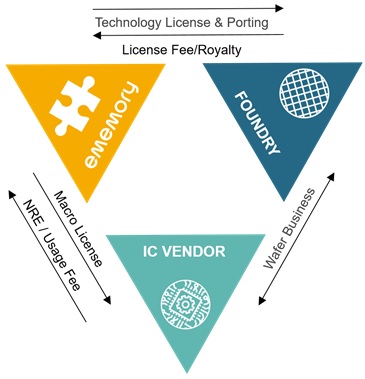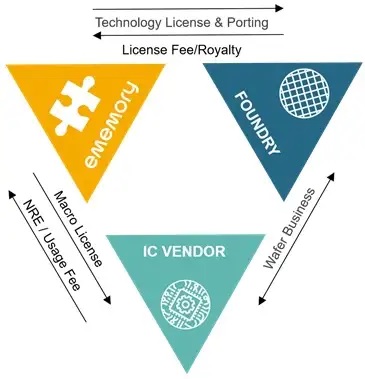
Dr. Shen has been President of eMemory Technology since 2009, succeeding Dr. Charles Hsu. Prior to the appointment, Dr. Shen held various management positions within the company, overseeing Technology Development, founding the Customer Service team, supervising Technology & IP services, and the company’s technology development migration from 0.7um to 90nm. Dr. Shen received his doctoral degree in Electrical Engineering from National Tsing-Hua University (NTHU). He holds over 80 worldwide patents, has published 25 technical papers, and co-authored the book “Logic Non-Volatile Memory”.
Dr. Shen was one of the key inventors of eMemory’s proprietary NVM technology portfolio. He was integral in establishing the company as the world’s most reliable One Time Programmable (OTP) memory partner and continues to lead the eNVM IP industry under his guidance. He was a named recipient of the ‘National Invention and Creation’ Gold Medal, for his work developing eMemory’s NeoBit Technology and was presented with NTHU’s prestigious ‘Outstanding Alumni Award’ in 2018.
How did eMemory get started?
We established eMemory back in the year 2000. Dr. Charles Hsu, our Chairman, was a professor at National Tsing Hua University where his research group was focused on the design and physics behind Non Volatile Memory (NVM), particularly novel cell structure, operation schemes, and the aging mechanism analysis of its reliability. Almost all of the founding team back then, including myself, had studied under Charles.
We were perhaps the only startup at the time with an Academic background researching NVM. It was a pivotal time in the industry and early on, we received many inquiries from companies seeking out new solutions. There was a high demand for a novel low-voltage or low-power memory solution that could reduce production costs and enable new applications. The traditional NVM technology on the market was very complex, often requiring many additional masks during fabrication, and often, far more features than the products required. Our Logic NVM solution changed all that. We were matching the market demand by providing a fully CMOS process compatible solution, with less processing whilst removing the need for ‘extra’ masks. It was, frankly, a big breakthrough in the sector.
What added value do bring to your customers?
I think there are three consistent challenges that our customers face, enhancing performance, improving product yields, and reducing cycle time. That push to improve quality and reliability without compromising development time has been the driver of the semiconductor industry over the last 20 years. The lifecycle of each new product gets shorter as the end-user moves onto the next generation faster than ever before. A component can take 1-2 years to develop now, which is just too long for our customers to respond to market demand. So, that means it is essential that our IPs are widely qualified and available across new technology platforms. We want to have our IPs ready before the customer knows that they need them.
I think if you look at our investment in R+D, you can see a clear correlation to the value we are adding to customers. This business is driven by innovation and we always want to look for what’s next. For example, I think our Chip Fingerprint Technology, based from our OTP technology, will become essential to our customers in the future. It’s going to play a big role in ending reverse engineering, protecting data, and enabling zero-trust security om securing the IoT for our customers by utilizing Physical Unclonable Function (PUF) based technology.
What makes eMemory unique?
As a physical IP company, developing innovations like our OTP device and integrating into hard IPs, definitely sets us apart. There are only a handful of physical IP companies and as such, we think differently about our role as an IP provider and get involved in the whole process as much as possible, from design to fabrication.
We have seen our IPs integrated on over 400 process platforms and Cross the Chasm into the mainstream IP market. That is a lot of effort working together with our foundry partners, and for our competitors, a lot of catching up to do. We don’t take commercial successes for granted however, we know how changeable this sector can be, so for us, innovation is something you need to sustain and never look away from. It is often missed just how specific and highly process-sensitive the memory field is. That is why we also place such a premium on technical support and expertise. We want to allow our customers to concentrate on product design and then rely on us to have high-quality NVM IPs and support them with a full spectrum of technical engineering services.
We have received for 11 consecutive years now the ‘Best IP Partner Award’ from TSMC. That is something we are very proud of because it demonstrates not just eMemory’s reliability but more importantly, that our IPs have remained innovative for over a decade now. We work with 24 foundries and are part of over 500 tape-outs every year. The vast majority of our business is returning partners who trust us with, not only the technology advancement, but also highly sensitive information related to their specifications, planning, and schedules. Some of these relationships stretch back decades, which for us is the biggest compliment.
What is your business model?
Our business model focuses on collaborating with both the foundries and the design houses. On the foundry side, we are a technology provider collecting royalties, with the Design houses, we license our IP block design and for both, we offer technical support. It can be easy to overlook that we are all part of the manufacturing process and not just theoretically designing circuits in front of a screen. It is only when the foundry is fully considered in the design and process development stages that reliable and practical solutions can be found.
We want to have a memory block that best meets our customer needs and that naturally includes a seamless transition from design into production. For eMemory, that means creating a triangular partnership between the design house, the foundry, and ourselves. This creates a much closer collaboration among all three parties and allows eMemory to take an active role in supporting the product development all the way to completion. We have found this to be the most reliable model, and one that benefits everyone. When it works, we are all rewarded and if any issues do arise, we are all invested in finding a quick solution. We have seen consistently stable production yields with a high level of reliability for many years now as a result.

What is next for the company?
We will of course continue to innovate our logic embedded NVM technologies and employ them over many applications. Moving into more advanced process nodes is also a priority, particularly with our OTP and Multiple Time Programmable (MTP) memory IP, where we want to widen the availability of our portfolio and cater to emerging memory technologies like ReRAM and MRAM. I think our current positioning inside the industry leaves us primed to take advantage of these shifts in the market.
Our recent IP NeoPUF, which is a Hardware Root of Trust, we believe will also be a big part of our future as we expand into PUF-based hardware solutions and services. It may seem on the surface that Hardware Security is an entirely different business proposition to our customers but the underlying physics have the same fundamentals. Our NeoPUF IP derives from our OTP technology, which is already extensively qualified. The OTP platform, now with PUF IP, can allow our customers to adopt a zero-trust hardware security solution quite easily and protect them from reverse engineering and adversarial attacks.
Hardware security is set to become an essential part of the Internet of Things (IoT) and 5G in the future as the necessary level of connectivity between devices only heightens the risk to security. Spending on hardware security has always been a calculation of risk management, and we think within the semiconductor market, that calculation is currently undervalued. We hope to play a big part in securing the future of our connected world over the next decade.
Also Read:
CEO Interview: Kush Gulati of Omni Design Technologies
Executive Interview: Casper van Oosten of Intermolecular, Inc.
CEO Interview: R.K. Patil of Vayavya Labs
Share this post via:






Comments
There are no comments yet.
You must register or log in to view/post comments.